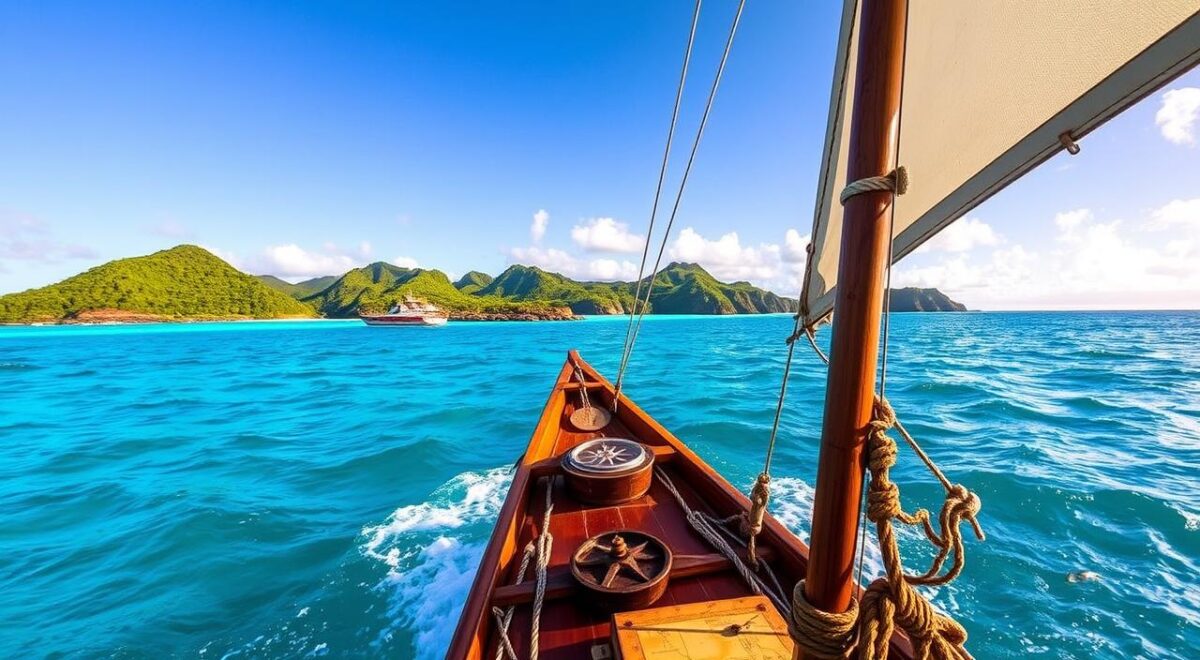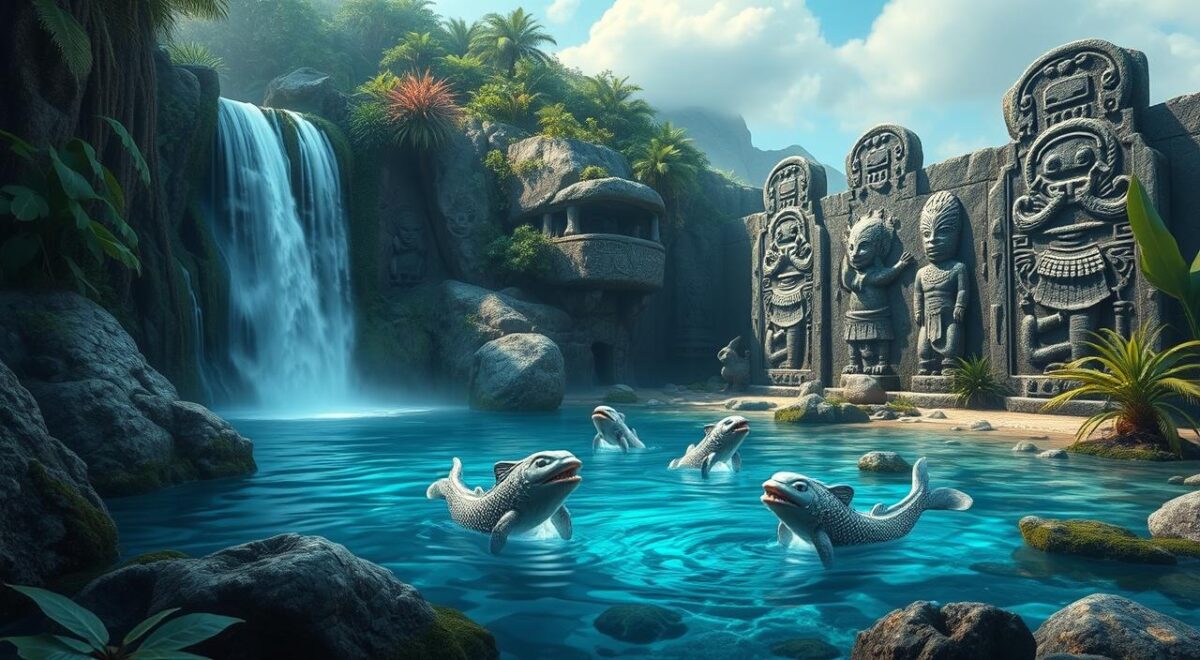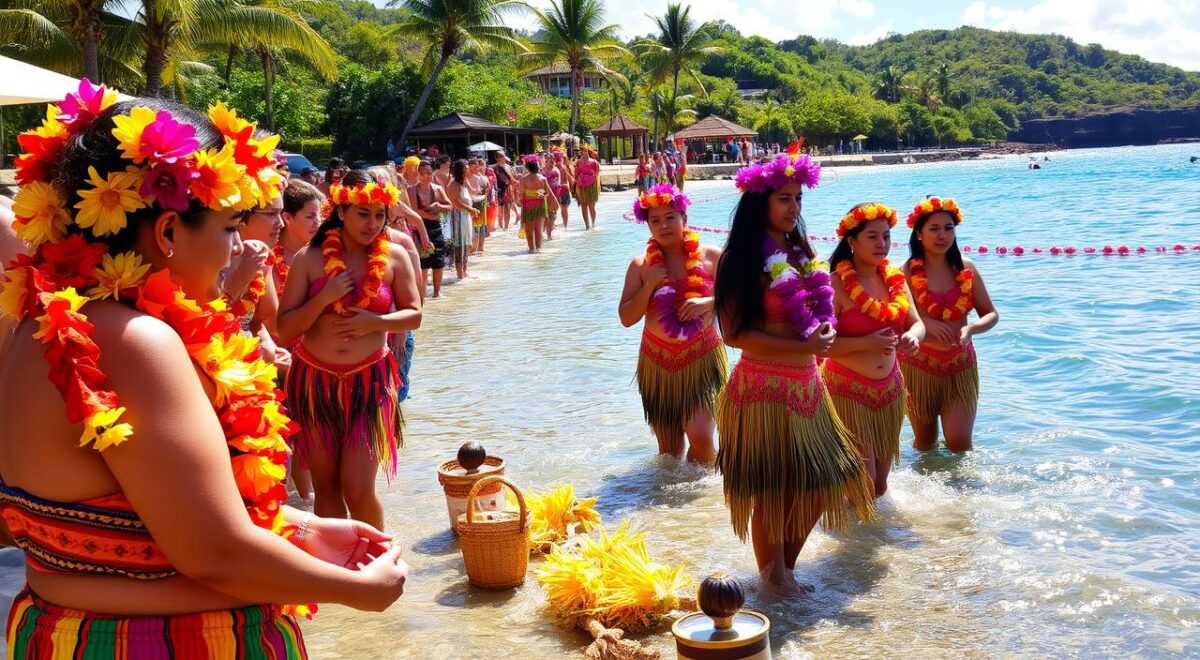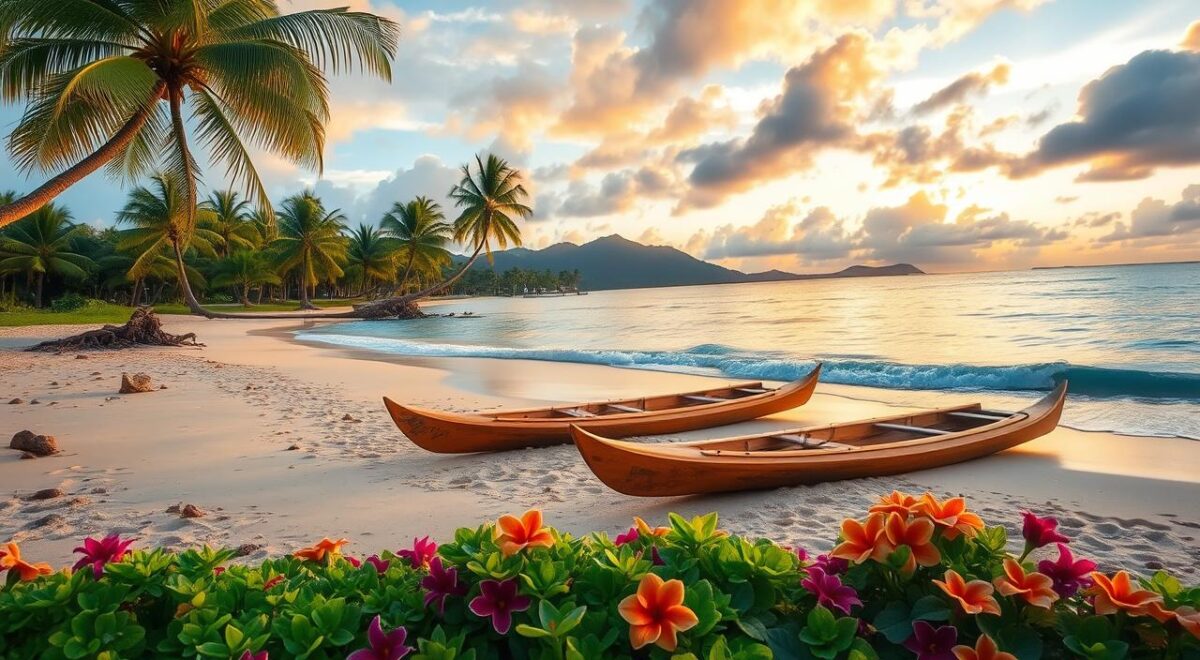Native Hawaiians have a deep bond with water. It’s key to their identity and culture. Water, from ocean waves to freshwater streams, is more than just a resource. It’s the heart of island life.
In ancient Hawai’i, water meant wealth and prosperity. There were about 300 fishponds to support the economy. Water was crucial for their food and daily life.
The traditional land divisions, called ahupua‘a, showed the link between land and water. Freshwater streams were vital for farming and survival. Taro, a key food, needed constant water, showing water’s spiritual importance.
Let’s explore how water shapes Hawaiian culture. Join me to uncover the traditions and values behind this bond. For more on modern cultural trends like Hawk Tuah, read here. It’s amazing to see how past and present meet in the Hawaiian water story.
The Significance of Water in Hawaiian Culture
Water is very important in Hawaiian culture. It means more than just a source of drink. It stands for spirituality and life itself. In Hawaiian tradition, water is called “wai” and is seen as sacred. It carries mana, or spiritual energy, which affects daily life.
Spiritual Connections to Water
The deep water significance in Hawaiian culture is clear. Water is linked to spiritual beliefs, seen as a purifying force. Many rituals involve water, showing it’s a vital source for life. It connects people to their ancestry, helping them feel a sense of identity and belonging.
Water as a Source of Life
Water is also crucial for life. Growing crops like taro in lo‘i kalo fields shows the need for water management. Traditional systems, like the ahupua‘a, help communities use water wisely for farming and fishing. These methods show a long-standing commitment to sustainability.
Historical Practices Involving Water
In the past, Hawaiians followed laws called kānāwai to share water fairly. These laws helped communities stay strong. But, colonization changed things, altering natural water systems. Today, efforts are underway to restore these practices and protect the environment.
Traditional Hawaiian Navigation and the Ocean
The art of traditional navigation in Hawaii is a mix of skill, knowledge, and culture. Polynesian navigators used various methods to find their way. They relied on the ocean and natural signs around them.
This tradition shows the ingenuity and adaptability of Hawaiian ancestors. They sailed across the open ocean with ease.
Wayfinding Methods Used by Hawaiians
Wayfinding is a set of techniques used by ancient navigators. They didn’t need modern tools to cross vast oceans. They watched birds, fish, and waves to guide them.
The Hawaiian star compass was key, with 220 stars memorized. This helped them navigate with great precision. The stars’ resonance is clear in this tradition.
Importance of the Stars and Winds
Stars were crucial for ancient navigators. The Southern Cross always points south, helping them find their way. During the day, they used the sun and canoe railings to stay on course.
Knowing wind patterns and the sun’s position helped them navigate better. Their connection to the stars and sun shows a deep mastery.
The Role of the Ocean in Navigation
The ocean was a reliable guide for Polynesian voyagers. They could navigate vast parts of the Pacific Ocean. They observed wave patterns and horizon angles.
Changes in star positions as they moved north or south showed their deep connection to the ocean. The Hōkūleʻa canoe, for example, sailed from Hawaii to Tahiti using these methods.

Water-Based Activities in Hawaiian Life
Water activities are key in Hawaiian life. They show old customs and build community and identity.
Surfing: More Than Just a Sport
Surfing in Hawaii is more than a sport. It’s a way of life tied to tradition and the ocean. Beginners can start at Waikīkī Beach, while the north shore offers bigger challenges.
Surfing lets people express themselves through the ocean. It’s a canvas for personal and shared stories.
Fishing: Cultural and Sustenance Practices
Fishing is crucial in Hawaiian daily life. It’s not just for food; it’s a community practice. Local charters offer chances to catch tuna, wahoo, and marlin.
As families pass down fishing skills, its importance grows. Fishing keeps Hawaiian traditions alive.
Canoeing and Outrigger Voyaging
Outrigger canoes are a symbol of Hawaiian ingenuity. They allow for adventures in Hawaiian waters. Canoeing shows the bond between people and the sea.
It also highlights ancient navigation skills. Voyaging brings people together, celebrating the ocean’s beauty.
Hawaiian Myths and Legends Related to Water
Hawaiian myths show a deep bond between the islanders and the sea. Water deities are key, representing the ocean and freshwater. These cultural stories teach us about water’s importance in Hawaiian life.
The Goddess Kanaloa
Kanaloa, the ocean god, is a major figure in Hawaiian myths. He’s linked to healing and the nurturing power of water. His stories show how much Hawaiians value water as a source of life.
The Story of the Mui Water Princess
The Mui Water Princess is a key figure in Hawaiian myths. She’s connected to springs and streams, symbolizing purity and fresh water. Her stories teach us about water’s power to sustain and cleanse, showing its importance in Hawaiian culture.
Mythical Creatures of the Sea
Myths are filled with creatures like the mo’o, a dragon-like being in freshwater. These creatures show Hawaiians’ respect for waterscapes and their mysteries. Encounters with them teach lessons on harmony and nature’s balance, highlighting water’s vital role.

| Water Deity | Description | Associated Stories |
|---|---|---|
| Kanaloa | God of the ocean, symbolizing healing and sustenance. | Legends detailing oceanic journeys and healing rites. |
| Mui | Goddess of freshwater, representing purity. | Stories of springs and their life-giving properties. |
| Mo’o | Mythical water creature, guardians of freshwater. | Tales of bravery and respect for nature’s forces. |
Exploring these legends of the sea deepens our appreciation for water’s impact. It shapes the landscape and Hawaiian culture. These myths still influence modern practices, keeping water’s importance alive.
For a fascinating look at cultural phenomena, check out this exploration. It shows how past legends and current stories intertwine, creating a rich cultural heritage.
Environmental Concerns and Water
It’s important to talk about the big environmental issues affecting Hawaii’s water. Water pollution is a big problem, caused by things like jet fuel leaks and PFAS chemical spills. For example, a leak at the Red Hill Bulk Fuel Storage Facility spilled nearly 20,000 gallons of jet fuel into the water system. These incidents show how human actions harm our water.
Water Pollution in Hawaiian Islands
Hawaii’s freshwater systems are at risk because of its rainfall. The amount of rain varies a lot, from 8 inches to over 400 inches a year. Despite the rain, pollution has made it hard to keep our water clean. Recently, some freshwater sources, like a well on Oahu, have seen a big drop in water.
Conservation Efforts for Marine Ecosystems
It’s key to focus on marine conservation to tackle these issues. Rising sea levels and pollution make it tough to protect our oceans. We need to take care of our water quality and quantity. Community involvement is crucial for promoting sustainable practices and raising awareness about protecting our ecosystems.
The Role of Local Communities
Local communities are leading the way in solving these problems. Their efforts in conservation and sustainable practices help keep Hawaii’s waters healthy. It shows their commitment to our cultural heritage. By working together and educating each other, we can fight water pollution and protect our marine ecosystems.
| Environmental Concern | Impact | Community Involvement |
|---|---|---|
| Water Pollution | Contaminated water sources reduce availability | Advocacy for clean-up initiatives |
| Climate Change | Rising sea levels affect freshwater systems | Participating in local conservation programs |
| Decreased Groundwater | Less water available for agriculture and consumption | Promoting water conservation measures |
| Polluted Marine Ecosystems | Threatens biodiversity | Engaging in marine cleanup events |
The Influence of Water on Hawaiian Festivals
Water is key in Hawaiian festivals, bringing together culture and community. It’s central to many events, showing the beauty of the islands and Hawaiian values. Water ceremonies, rituals, and competitions highlight its importance.
Merrie Monarch Festival and Water Ceremonies
The Merrie Monarch Festival is a top event in Hawaiian culture. It includes water ceremonies that celebrate the bond between land and sea. People perform traditional hula and chants, showing respect for water’s life-giving power.
These ceremonies connect the past and present. They show how water has always been vital for survival and spiritual health.
Canoe Racing Events: Cultural Celebrations
Canoe racing is more than just a competition. It’s a way for communities to come together and celebrate their heritage. Teams compete on the water, showing off skills passed down through generations.
These events strengthen community bonds. They celebrate teamwork, a key part of Hawaiian traditions.
Spiritual Rituals Involving Water
Spiritual rituals in Hawaiian culture also highlight water’s importance. These rituals honor ancestors and nature, with water playing a sacred role. They show deep respect for the environment and the knowledge passed down through generations.
These ceremonies enrich the community’s shared identity. They connect people to their heritage and the natural world.

| Festival/Event | Significance | Key Features |
|---|---|---|
| Merrie Monarch Festival | Celebration of hula and heritage | Water ceremonies, traditional hula |
| Canoe Racing Events | Cultural teamwork and competition | Community participation, traditional skills |
| Spiritual Water Rituals | Deep respect for ancestral and natural ties | Sacred ceremonies, honoring the environment |
Contemporary Practices: Water in Modern Hawaiian Life
In modern Hawaiian life, urban water access meets cultural heritage in a unique way. Fast urban growth changes the landscape, impacting both the environment and traditional water values. The old Hawaiian water management system, based on community and shared duty, faces new challenges.
Urbanization and Water Access
Access to water in cities is key with climate change and growing populations. Hawaiians must update their self-sufficiency to meet new challenges like sea level rise and droughts. The U.S. Navy’s pollution at Red Hill shows the need for clean water. Yet, local efforts to keep traditional water practices alive are crucial.
Contemporary Surf Culture
Surfing today is more than a hobby; it’s a cultural symbol for Hawaiians. The growth of surf culture and tourism affects waterways and coasts. As I watch surfing evolve, I see the need to balance love for the sport with caring for the ocean and traditions.
Water Sports and Tourism
Water sports tourism boosts Hawaii’s economy a lot. Activities like paddleboarding and snorkeling draw visitors but strain aquatic habitats. It’s vital to support eco-friendly tourism to safeguard Hawaii’s water heritage for future generations.
Learning from traditional systems like the Hawaiian ahupua‘a model can help manage water better. It’s important to give back to the environment for long-term resilience. Daily reflections can motivate us to care for water and land more deeply.
For more on personal growth and motivation, check out daily reflections that can uplift your mindset.
The Relationship Between Hawaiians and the Land
Hawaiians have a deep bond with their land, built on love, respect, and care. This bond is called Aloha ʻĀina. It means loving and protecting the land for future generations. This connection is key to Native Hawaiians’ well-being and identity.
‘Aloha ʻĀina: Love for the Land
Aloha ʻĀina guides Native Hawaiians in their relationship with the land. It teaches them to care for the environment and communities. For example, Hui Maka’āinana o Makana uses ancient wisdom to improve food security and restore resources.
How Land and Water Are Interconnected
Land and water are closely linked, forming a shared ecosystem. Coastal areas are crucial for Native Hawaiians’ health and healing. Protecting these areas helps sustain communities and preserve traditional ties to land and water.
Conservation of Water Resources
Protecting water resources is vital for ecosystem health. Projects like Auwahi Forest Restoration on Maui and taro pond revitalization show conservation in action. These efforts support the restoration of ecosystems and the well-being of Native Hawaiian communities.
| Conservation Initiative | Location | Focus | Outcome |
|---|---|---|---|
| Auwahi Forest Restoration Project | Maui | Reforestation of uplands | Successfully restored areas previously damaged by cattle grazing |
| Limahuli Garden & Preserve | Kauai | Agricultural terracing | Restored 600 acres to promote traditional farming practices |
| Community Based Subsistence Fishing Management Areas | Various Coastal Areas | Fishing regulation | Empowered coastal communities to manage their own resources |
The bond between Native Hawaiians and their land is more than just geography. It’s a living, dynamic connection that needs constant care. By following Aloha ʻĀina, Hawaiians can work towards a sustainable future, rooted in tradition and spiritual connection to land and water.
Educational Programs on Water Sustainability
In Hawai‘i, water sustainability is a big challenge. Many educational programs are working to raise awareness and get people involved. These efforts include community projects, school programs, and government plans to protect our water and environment.
Community Efforts for Clean Water
Local communities are working together to keep our water clean. They’re restoring places like Heʻeia’s fishpond and taro patches. These projects teach people about taking care of our ecosystems and the importance of water.
Thanks to groups working together, we’ve seen big successes. For example, NOAA’s B-WET program has helped a lot with these efforts.
Schools Incorporating Water Education
Hawaiian schools are focusing more on teaching about water. Students learn through hands-on experiences and studies. They get to see how water is used in our lives and how we can protect it.
Programs like those in Heʻeia give students a chance to connect with nature. They learn about their role in taking care of our planet. For more information on these programs, check out this link.
Initiatives by Local Governments
Local governments are also playing a big part in water conservation. They’re making policies and investing in water infrastructure. For example, a $3.2 million grant from the EPA is helping improve our water systems.
The goal is to have 100 million more gallons of fresh water by 2030. The Bipartisan Infrastructure Law is also helping to upgrade our water systems. This will make sure we have safe and sustainable water for everyone.
Conclusion: The Ever-Present Importance of Water
Exploring Hawaiian culture shows water’s key role in identity and community. Water is more than a resource; it’s vital for life. Its spiritual value and role in supporting people and the environment are timeless.
Reflection on Hawaiian Values
Learning about water stewardship values helps us protect this precious resource. We must work together to face challenges like less rain and climate change. Efforts to improve water and conservation are crucial for our ecosystems’ health.
The Future of Water in Hawaiian Culture
For Hawaiian culture to thrive, we must adopt sustainable practices. Improving freshwater and protecting watersheds can help us face climate changes. Mixing old wisdom with new methods will help us overcome these challenges.
Encouraging Respect for Water Resources
It’s vital to appreciate water resources deeply. Let’s all take part in water stewardship. Every small step towards sustainability matters. Honoring water respects our traditions and ensures Hawaii’s future beauty.

